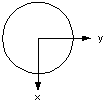RF Cafe Quiz #16: Antennas |
|
Click here for the complete list of RF Cafe Quizzes. Note: Some material based on books have quoted passages. The subject of Quiz #16 is Antennas. You don't need to be an antenna expert to score well, but if you do or plan to work with antennas and cannot answer a question like, "What does dBi, the most often used unit for antenna gain (or directivity), stand for?," then maybe it is time for some review.
1. What does dBi, the most often used unit for antenna gain (or directivity), stand for? a) Decibels of isolation b) Isometric radiation in decibels c) Decibels of gain relative to an isotropic radiator d) Intrinsic gain in decibels
2. For which region of space does antenna gain normally apply? a) Near field b) Far field c) At the feed point d) Everywhere

 Elevation Pattern Azimuth Pattern a) Parabolic b) Yagi c) 1/2-wave dipole d) 1/4-wave vertical whip
4. What is the free space impedance that an antenna "sees?" a) 50 Ω b) 75 Ω c) 16p Ω (≈50 Ω) d) 120p Ω (≈377 Ω)
5. What is the name given to the point where the RF input signal interfaces to the antenna? a) ICP (input connection point) b) Feed-point c) BNC connector d) N connector
6. Where is the approximate transition point between near field and far field? a) λ / (2p) b) λ c) 5λ d) 10λ
7. What is an isotropic radiator? a) An antenna that radiates equally in all directions b) An antenna with equal dimensions c) An antenna designed to broadcast in the troposphere d) None of the above
8. Which type of antenna would typically have the highest directivity? a) 1/4-wave whip b) Folded dipole c) Yagi d) Parabolic
9. On a center-fed 1/2-wave dipole, where is the voltage potential the highest? a) In the center b) At the tips c) Equal everywhere d) Nowhere - dipoles operate on current
10. Yagi antennas are constructed of which three types of elements? a) Transmitter, receiver, and transceiver b) Underdriven, driven, and overdriven c) Reflector, driven, and director d) Aluminum, iron, and magnesium
Need some help? Click here for the answers and explanations.
Posted July 12, 2022 |
